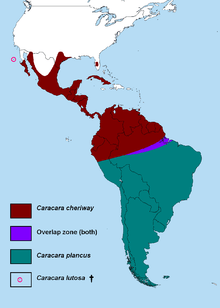Caracara (genus)
| Caracara | |
|---|---|
 | |
| Crested caracara at the Tárcoles River, Costa Rica | |
| Scientific classification | |
| Kingdom: | Animalia |
| Phylum: | Chordata |
| Class: | Aves |
| Order: | Falconiformes |
| Family: | Falconidae |
| Subfamily: | Polyborinae |
| Genus: | Caracara Merrem, 1826 |
| Species | |
|
and see text | |
 | |
| Range of the genus Caracara | |
| Synonyms | |
|
Polyborus | |
Caracara is a genus in the Family Falconidae and the Subfamily of Polyborinae. This genus consists of two extant, the Northern and Southern Crested Caracaras, and one extinct species, the Guadalupe Caracara. The only visible difference between the two living species is that the southern species possesses more barred plumage than the northern species. The minor physical differences between these species resulted in their originally being classified as a single species.
Taxonomy
The Northern and Southern Caracara are the only living examples of the modern Caracara genus.
- Northern caracara (Caracara cheriway)[1]
- Southern caracara (Caracara plancus)[1]
- †Guadalupe caracara (Caracara lutosa)[1] – extinct (1900)
Prehistoric Extinctions
Known from fossil records:
- †Bahaman caracara (Caracara creightoni) – Late Pleistocene[2]
- †Terrestrial caracara (Caracara tellustris) –Late Pleistocene [3]
- †Caracara major (Venezuela)- Late Pleistocene[4]
- †Puerto Rican caracara (Caracara latebrosus) –Late Pleistocene[5]
- †Seymour's Caracara Caracara seymouri (Peru, Ecuador)- Late Pleistocene[6]
Prehistoric Records
The fossil record proves the long history of the mainland "Crested Caracaras". Remains of Northern Caracaras, slightly larger than those of modern times but otherwise identical, were found in the famous La Brea Tar Pits.[7] In addition, the Guadalupe Caracara may derive from an already distinct population of Northern Caracara in western Mexico that, subsequently, was displaced by the main continental population.
References
- 1 2 3 "Caracara". Integrated Taxonomic Information System. Retrieved 3 April 2011.
- ↑ Steadman, David W.; Franz, Richard; Morgan, Gary S.; Albury, Nancy A.; Kakuk, Brian; Broad, Kenneth; Franz, Shelley E.; Tinker, Keith; Pateman, Michael P.; Lott, Terry A.; Jarzen, David M.; Dilcher, David L. (2007). "Exceptionally well preserved late Quaternary plant and vertebrate fossils from a blue hole on Abaco, The Bahamas". Proceedings of the National Academy of Sciences. 104 (50): 19897–19902. doi:10.1073/pnas.0709572104. PMC 2148394
 . PMID 18077421.
. PMID 18077421. - ↑ Olson, Storrs L. (2008). "A New Species of Large, Terrestrial Caracara from Holocene Deposits in Southern Jamaica (Aves: Falconidae)". Journal of Raptor Research. The Raptor Research Foundation. 42 (4): 265–272. doi:10.3356/JRR-08-18.1.
- ↑ "Body Mass Estimations and Paleobiological Inferences on a New Species of Large Caracara (Aves, Falconidae) from the Late Pleistocene of Uruguay". ResearchGate. doi:10.2307/23353814. Retrieved 2016-04-22.
- ↑ Hume, Julian P.; Walters, Michael (2012-03-19). Extinct Birds. A&C Black. ISBN 9781408158623.
- ↑ Suárez, William; Olson, Storrs L. (2014-09-01). "A new fossil species of small crested caracara (Aves: Falconidae: Caracara) from the Pacific lowlands of western South America". Proceedings of the Biological Society of Washington. 127 (2): 299–310. doi:10.2988/0006-324X-127.2.299. ISSN 0006-324X.
- ↑ Guthrie, Daniel A. (1992). "A Late Pleistocene Avifauna from San Miguel Island, California" (PDF). Los Angeles County Natural History Museum Science Series. 36: 319–327.
Further reading
- Dove, C. & R. Banks. 1999. A Taxonomic study of Crested Caracaras (Falconidae). Wilson Bull. 111(3): 330–339.